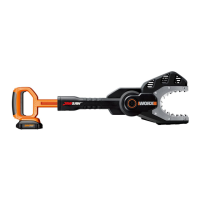Cordless Limbing and Trimming Chain Saw EN
98
Do not start cutting until you have a clear
work area, secure footing, and a planned
retreat path from the falling limbs.
15)Consider Work Area Environment.
Use extreme caution when cutting small
size brush and saplings because the slender
material may catch the saw chain and be
whipped toward you or pull you off balance.
Do not operate JAWSAW
®
in a tree unless
specifically trained to do so.
When cutting a limb that is under tension
be alert for spring back so that you will not
be struck when the tension in the wood
fibers is released.
Don’t expose chain saw to rain.
Don’t use JAWSAW
®
in damp or wet
locations.
Do not use JAWSAW
®
in presence of
flammable liquids or gases.
16)Guard Against Electric Shock
Prevent body contact with grounded surfaces.
For example: metal pipes, wire fences.
17)Carrying JAWSAW
®
Carry the JAWSAW
®
by the front handle
vertically by the rear handle with the saw
stopped and finger off the switch.
18)Keep all parts of the body away
from the saw chain when the motor
is operating. Before you start the saw,
make sure the saw chain is not contacting
anything.
19)Guard Against Kickback
WARNING! KICKBACK may occur
when the nose or tip of the guide
bar touches and object, or when the wood
closes in and pinches the saw chain in the
cut. Ti contact in some cases may cause a
lightning fast reverse reaction, kicking the
guide bar up and back towards the
operator: Pinching the saw chain along the
top of the guide bar may push the guide
bar rapidly back towards the operator.
Either of these reactions may cause you to
lose control of the saw which could result
in serious injury to user. The following
precautions should be followed to
minimize kickback.
1. Grip saw firmly. Hold the jaw saw firmly
with both hands when the motor is
running. Use a firm grip with thumbs and
fingers encircling the jaw saw handles.
2. Do not over reach.
3. Keep proper footing and balance at all
times.
4. Don’t let the nose of the guide bar contact
a log, branch, ground or other obstruction.
5. Use devices such as low kickback chain,
guide bar nose guards, chain brakes and
special guide bars that reduce the risks
associated with kickback.
6. Only use replacement bars and chains
specified by the manufacturer or the
equivalent.
ADDITIONAL SAFETY
WARNINGS FOR JAWSAW
®
1. Pre-plan a safe exit from falling branches
and debris. Ensure the exit route is clear
of obstacles that would prevent or hinder
movement. Remember freshly cut bark and
wet grass is slippery.
2. Be aware of the direction that a branch may
fall. Consider all conditions that may affect
the direction of fall. Including:
a. The intended direction of fall.
b. The natural lean of the branch.
c. Any unusual heavy limb structure or decay.
d. Surrounding trees and obstacles including
overhead power lines.
e. The wind speed and direction.
3. The safe distance between a branch
and debris to be felled and bystanders,
buildings, and other objects is at least
2 ½ times the length of the branch. Any
bystander, building, or object within this
distance is at risk from being struck by the
falling branch.
4. Do not let the moving chain contact any
object at the tip of the guide bar.
5. Begin and continue cutting only with the
chain moving at full speed.
6. Before cutting is started, consider the
natural lean of the tree, the wind direction
to judge which way the branch will fall.
7. Remove dirt, stones, loose bark, nails,
staples, and wire from the branch where
you plan to make your cut.
8. The machine shall not be used in any
position that causes any part to come within
33 feet (10m) of overhead electrical lines;
9. The operating positions are dangerous; the
operator may be struck by falling branches
or by those that rebound after hitting the
ground. Remove the branches in sections.

